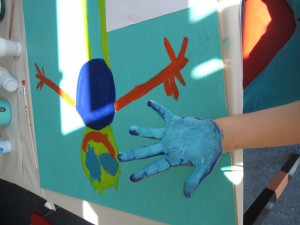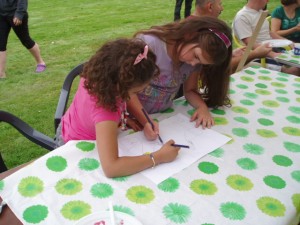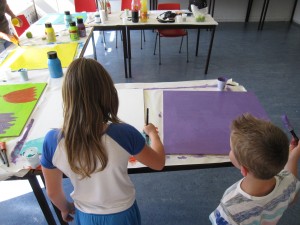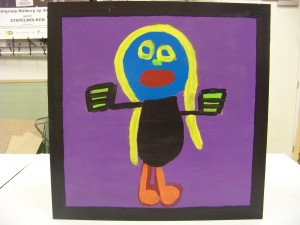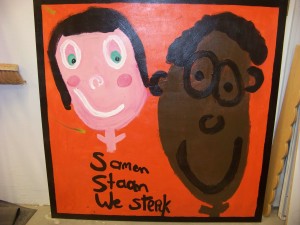Within the framework of this project, which ran from 2011 to 2013, arts therapists and youth workers joined forces to develop, carry out, and evaluate innovative interventions. The goal of these interventions was to empower vulnerable young people in the community. Vulnerable young people are those who are confronted with an accumulation of problems which have a negative impact on their development and which can lead to psychosocial issues, problem behaviour, troublemaking, and delinquency.
The RAAK programme began by taking stock of literature, expert knowledge, and ongoing projects in order to better adapt arts therapy to young people’s social environments. An approach was then selected in which all concerned parties, including the young people, participated intensively. Six interdisciplinary communities of practice, or ‘CoP,’ began work with six groups of vulnerable young people in the south of the Dutch province of Limburg. Each CoP involved a practising therapist, active in dance, movement, drama, music, and art therapy, a youth worker, and a group of vulnerable young people. Each group had seven to fifteen members. Alongside these, the project also involved an outer circle of relevant professionals as well as members of the community. Based on a discipline within arts therapy, each CoP developed a unique accessible intervention together with the young people.
The development, implementation, and evaluation of the interventions were investigated using a participative action research in dialogue with the central partners in the community. The evaluation of the developed interventions was carried out by means of mixed methods research.
The findings from the partial projects were compiled into a checklist of Dos and Don’ts for arts therapy in youth work (in Dutch). This will act as a guideline to other arts therapists and youth workers who work with comparable target groups and in comparable situations of how to successfully implement similar interventions in the future.
Below you will find information about the interventions as well as several impressions of how various interventions were implemented.
Art therapy
The project leader, who was also an art therapist, and a second art therapist formed a CoP with a children’s worker from the Traject Welzijn, a study programme for intermediate vocational education care courses, and with children from a primary school in a disadvantaged neighbourhood in Maastricht. The teaching staff at the school took on a supportive role. The creative arts activities in which the children participated involved producing ‘art’ which would serve to make the neighbourhood more cheerful and improve quality of life. Click here (de interventie Het Bazuinatelier and het onderzoeksverslag) to read about some impressions of how this project was carried out:
Dance movement therapy
Two project leaders for dance movement therapy, who were also dance movement therapists, and a graduate dance movement therapist formed two CoPs. The first CoP worked with a group of young people from the Icarus facility of the Stichting Jeugdzorg Sint Joseph youth care foundation (Stichting Jeugdzorgd Sint Joseph [SJSJ]) and Het Keerpunt custodial youth institution. A behavioural scientist from SJSJ was involved in this project. The second CoP was formed of a group of young people from the youth centre De Mix, which is associated with Impuls, the organization for social well-being in the Dutch city of Kerkrade. A youth worker was involved in this project. The dance movement therapy activities involved making dance videos.
Click here for the intervention SJSJ, Cadier en Keer (pdf).
Click here for the intervention De Mix, Kerkrade (pdf).
Watch here a posterpresentation about this project (pdf).
Watch here the research report.
Click here to watch a video of how the project was implemented:
Drama
The project leader, who was also a dramatherapist, and a second dramatherapist formed the CoP with the youth workers from the Traject Welzijn study programme and a community artist. The CoP worked with a group of young people from the community centre in the Mariaberg neighbourhood in Maastricht. The dramatherapy intervention involved a ‘Drama Masterclass’ with a Playback Theatre. The members of the community play an active part in the Playback Theatre.
Watch here the intervention masterclass drama.
Watch here the research report.
Click here to watch a video of how the project was implemented.
Music
The project leader, who was also a music therapist, formed two CoP. One CoP involved some young people from the pre-vocational special education stream of the Da Capo College in Sittard, the Netherlands. A music teacher was involved in this project ‘Vindplaats school’ (‘School location’). The music therapy intervention involved the group making music together. The second CoP worked with a group of loitering teens in the Dutch town of Stein. A youth worker from Traject Welzijn was involved in this project named ‘de Kofferbak’ (‘the Car Boot’). The idea was literally to fill a car boot with instruments and to take this to the teenagers in the street. However, despite a very promising start, this intervention did not take off, as the young people withdrew from the activities.
Watch here the intervention Vindplaats School, Sittard.
Watch here the intervention de Kofferbak, Stein e.o.
Watch here the research report.
What happened next
The project then received a new lease of life via education, practice, and research. Entrepreneurial and other students of arts therapy and Social Studies were encouraged to repeat the interventions within the framework of a work placement or graduate work placement, and to further research them in cooperation with each other. Different students have completed their degrees with a final project in dramatherapy interventions.
This project was made possible by the RAAK-Publiek grant, which stimulates the cooperation and knowledge exchange between universities and professionals from the public sector. This grant is allocated by the Nationaal Regieorgaan Praktijkgericht Onderzoek SIA, the Dutch national coordinating body which promotes and finances practically-oriented research in universities.
The contact person for this project is Tineke Schoot.
